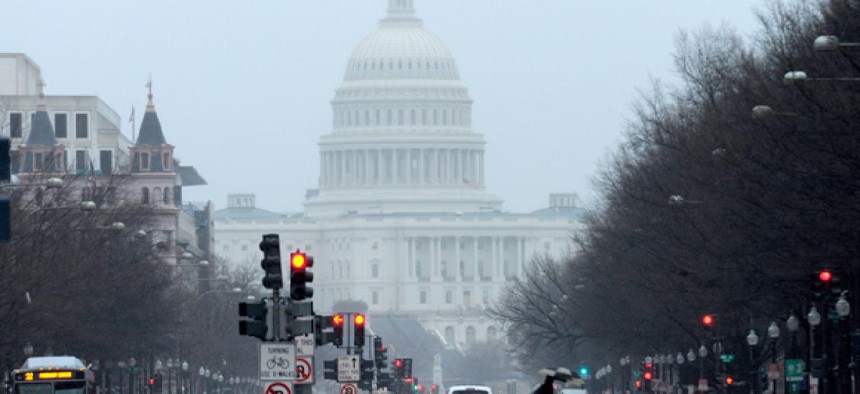
A view of Capitol Hill from Pennsylvania Avenue in Washington, Wednesday, March 6, 2013. Susan Walsh/AP
House Extends Pay Freeze, Upholds Sequester
Bill to keep government open past March 27 now heads to Senate.
The House on Wednesday voted to extend the pay freeze for federal employees as part of the package to keep the government open through the end of September.
A provision in the $982 billion continuing resolution, which abides by sequestration, prolongs the current freeze on federal civilian employees for a third year. It also applies to lawmakers. The vote originally was scheduled for Thursday, but the House leadership moved it to Wednesday because of inclement weather in the Washington area that closed federal offices in the region.
President Obama issued an executive order in late 2012 that would end the two-year salary freeze on March 27 -- when the current CR expires -- and give civilian federal workers a 0.5 percent raise in 2013. If the pay freeze provision remains in the continuing resolution that reaches Obama’s desk, as is expected, it will overturn that executive order.
Republicans in Congress repeatedly have targeted the federal workforce’s pay. In February, the House approved a bill sponsored by Rep. Ron DeSantis, R-Fla., that extends the federal pay freeze. The Congressional Budget Office estimated that a 2013 pay increase for federal employees would cost the government $11 billion over the next 10 years.
The current pay freeze affects the annual, across-the-board cost of living increase that feds receive. Many federal workers, however, have continued to receive pay boosts through within-grade step increases, promotions and bonuses during the last two years.
“Once again, we treat the federal employee like a punching bag,” said Rep. Gerry Connolly, D-Va., on the House floor Wednesday. “For the third year in a row, we freeze their salary. They’ve already contributed, and they were the only group singled out to contribute to the federal debt reduction to the tune of $100 billion in lost wages and benefit cutbacks.”
Federal employee groups were unhappy with the bill because it maintains the sequester and prolongs the pay freeze. “We continue to believe strongly that the best course for the nation is an end to sequestration and the adoption of measures that provide federal agencies with the funding they need to serve the public,” said National Treasury Employees Union President Colleen Kelley.
“While private-sector wages rose by an average of 1.4 percent in 2011 and 1.7 percent in 2012, pay for federal workers has remained frozen since 2010,” said Joseph A. Beaudoin, president of the National Active and Retired Federal Employees Association. “Getting our fiscal house in order will require tough decisions, but there are other ways to reduce the deficit that do not punish middle-class federal families. Enough is enough!”
The continuing resolution (H.R. 933) maintains sequestration-level funding for the government through Sept. 30, with flexibility for the Defense and Veterans Affairs departments as well as some additional agencies and programs. It includes a 1.7 percent pay raise for military service members, which is exempt from sequestration.
“The legislation will avoid a government shutdown on March 27, prioritizes DoD and veterans’ programs and allows the Pentagon some leeway to do its best with the funding it has,” said House Appropriations Committee Chairman Hal Rogers, R-Ky. The CR provides $518.1 billion in non-war funding for the Pentagon and a total of $133.9 billion in both mandatory and discretionary funding for the VA. The bill also provides $32.7 billion for Defense health and military family programs, including medical research on combat-related injuries and illnesses.
The Senate is expected to tweak the legislation, but it’s likely to pass both chambers and head to Obama with little drama. The ongoing, bitter battle over the automatic spending cuts, which began on March 1, has spurred lawmakers to act swiftly to avoid a government shutdown on top of the sequester.
For the fourth time, the House rejected an amendment offered by Rep. Chris Van Hollen, D-Md., which would have replaced the sequester this year with a mix of spending cuts and revenue increases to reduce the deficit.
The government is on the hook to cut $85 billion under sequestration during fiscal 2013. The Office of Management and Budget had calculated that over the course of the fiscal year, sequestration requires a 7.8 percent reduction in defense discretionary funding and a 5 percent cut in non-defense discretionary spending. But acting OMB Director Jeffrey Zients has said that because the cuts are spread over seven months instead of 12, the effective reductions are 13 percent for defense and 9 percent for domestic agencies.
NEXT STORY: Retirement Applications Spike in February







